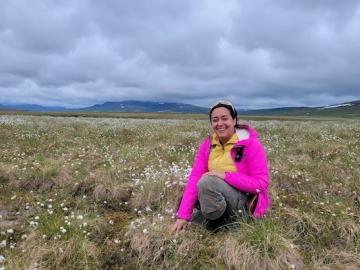Filter News
Area of Research
- (-) Biology and Environment (76)
- Advanced Manufacturing (16)
- Biological Systems (2)
- Building Technologies (7)
- Chemical and Engineering Materials (1)
- Chemistry and Physics at Interfaces (1)
- Clean Energy (230)
- Climate and Environmental Systems (4)
- Computational Biology (1)
- Computational Engineering (2)
- Computer Science (10)
- Data (1)
- Electricity and Smart Grid (1)
- Energy Frontier Research Centers (1)
- Energy Sciences (2)
- Fossil Energy (1)
- Functional Materials for Energy (1)
- Fusion and Fission (11)
- Fusion Energy (8)
- Isotope Development and Production (2)
- Isotopes (14)
- Materials (109)
- Materials for Computing (10)
- Materials Synthesis from Atoms to Systems (1)
- Materials Under Extremes (1)
- Mathematics (1)
- National Security (24)
- Neutron Data Analysis and Visualization (2)
- Neutron Science (43)
- Nuclear Science and Technology (23)
- Nuclear Systems Modeling, Simulation and Validation (2)
- Quantum information Science (3)
- Renewable Energy (3)
- Sensors and Controls (3)
- Supercomputing (50)
- Transportation Systems (2)
News Type
News Topics
- 3-D Printing/Advanced Manufacturing (2)
- Artificial Intelligence (1)
- Big Data (2)
- Bioenergy (20)
- Biology (31)
- Biomedical (6)
- Biotechnology (4)
- Chemical Sciences (3)
- Clean Water (7)
- Climate Change (15)
- Composites (2)
- Computer Science (5)
- Coronavirus (3)
- Decarbonization (6)
- Energy Storage (1)
- Environment (40)
- Exascale Computing (1)
- Grid (2)
- High-Performance Computing (8)
- Hydropower (5)
- Machine Learning (2)
- Materials (2)
- Materials Science (2)
- Mathematics (2)
- Mercury (4)
- Microscopy (4)
- Net Zero (1)
- Physics (1)
- Polymers (1)
- Simulation (4)
- Summit (1)
- Sustainable Energy (15)
- Transportation (1)
Media Contacts

The presence of minerals called ash in plants makes little difference to the fitness of new naturally derived compound materials designed for additive manufacturing, an Oak Ridge National Laboratory-led team found.

Researchers at Oak Ridge National Laboratory have identified a key need for future hydropower innovations – full-scale testing – to better inform developers and operators before making major investments.

John “Jack” Cahill is out to illuminate previously unseen processes with new technology, advancing our understanding of how chemicals interact to influence complex systems whether it’s in the human body or in the world beneath our feet.

ORNL researchers discovered genetic mutations that underlie autism using a new approach that could lead to better diagnostics and drug therapies.

Matthew Craig grew up eagerly exploring the forest patches and knee-high waterfalls just beyond his backyard in central Illinois’ corn belt. Today, that natural curiosity and the expertise he’s cultivated in biogeochemistry and ecology are focused on how carbon cycles in and out of soils, a process that can have tremendous impact on the Earth’s climate.

Tomás Rush began studying the mysteries of fungi in fifth grade and spent his college intern days tromping through forests, swamps and agricultural lands searching for signs of fungal plant pathogens causing disease on host plants.
A team from Oak Ridge National Laboratory, Duke University and other institutions studying Sphagnum moss have identified two new species in North America, and they are learning how evolution may affect the species’ role in carbon storage.

With wildfires increasing in scope and intensity around the world, Fernanda Santos’ research into how such calamities affect soil carbon storage has taken on new urgency.

Global carbon emissions from inland waters such as lakes, rivers, streams and ponds are being undercounted by about 13% and will likely continue to rise given climate events and land use changes, ORNL scientists found.

A team of scientists led by Oak Ridge National Laboratory developed a theory that thylakoids, membrane networks key to plant photosynthesis, also function as a defense mechanism to harsh growing conditions, which could aid the development of hardier plants.




